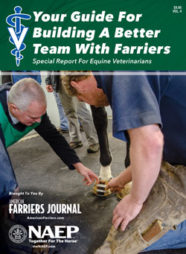Because of its association with laminitis, insulin resistance will be critical to the health of many horses as they are turned out on pasture this spring.
If you see a laminitic horse in your footcare that exhibits delayed haircoat shedding or a loss of skeletal muscle mass, the horse should be checked by a vet for insulin resistance. Another insulin resistance concern is the “easy keeper,” where body weight is maintained on a relatively low caloric intake.
Frank Nicholas says insulin resistance is often found in ponies, Morgans, Paso Finos and Norwegian Fjords. The equine vet at the University of Tennessee in Knoxville, Tenn., says the condition also occurs in Arabians, Quarter Horses, American Saddlebreds and Tennessee Walking Horses.
Appearance Counts
“Horses with this condition can often be recognized by their appearance,” says Nicholas. “Some exhibit generalized obesity while others are thinner through the mid region of the body, yet have a crusty neck or enlarged fat pads next to the tailhead.”
He told attendees at December’s American Association of Equine Practitioners meeting that the situation can be defined as Cushing’s disease, equine metabolic syndrome (EMS) or pre-laminitic metabolic syndrome.
“All of the pieces of the puzzle must be assembled before we can fully understand the association between insulin resistance and pasture-associated laminitis,” he says. “But it seems that non-structural carbohydrates (NSC) within pasture grasses play an important role in this process.”
Additional details on the role of proper feeding and insulin resistance in managing laminitis is found in the 20-page Diet And The Hoof — Piecing Together The Nutrition Puzzle report that was included with this issue for paid subscribers. It chapter offers an in-depth look at the critical links between lush pasture, grain overload and laminitis.
Diet Plus Exercise Needed
Nicholas says the two principal strategies for dealing with horses with insulin resistance are diet and exercise.
For insulin-resistant horses that are severely affected with laminitis, Nicholas recommends taking them totally off pasture. He suggests your clients feed grass hay with a low NSC content along with concentrates that primarily contain fat and fiber.
After acute laminitis has passed, obese horses should be placed on a weight reduction diet composed of grass hay with a low NSC content.
Weight loss can be accelerated by limiting caloric intake and administering a dosage of 4 teaspoons daily of levothyroxine to reduce body fat mass and improve insulin sensitivity with horses kept off pasture and maintained on a controlled diet.
Horses should be weaned off this drug once their ideal body weight has been reached. Yet some horses with chronic laminitis and EMS should be kept off pasture indefinitely.
As pastures green up this spring, this is one more thing for you to consider when laminitis is a concern.







